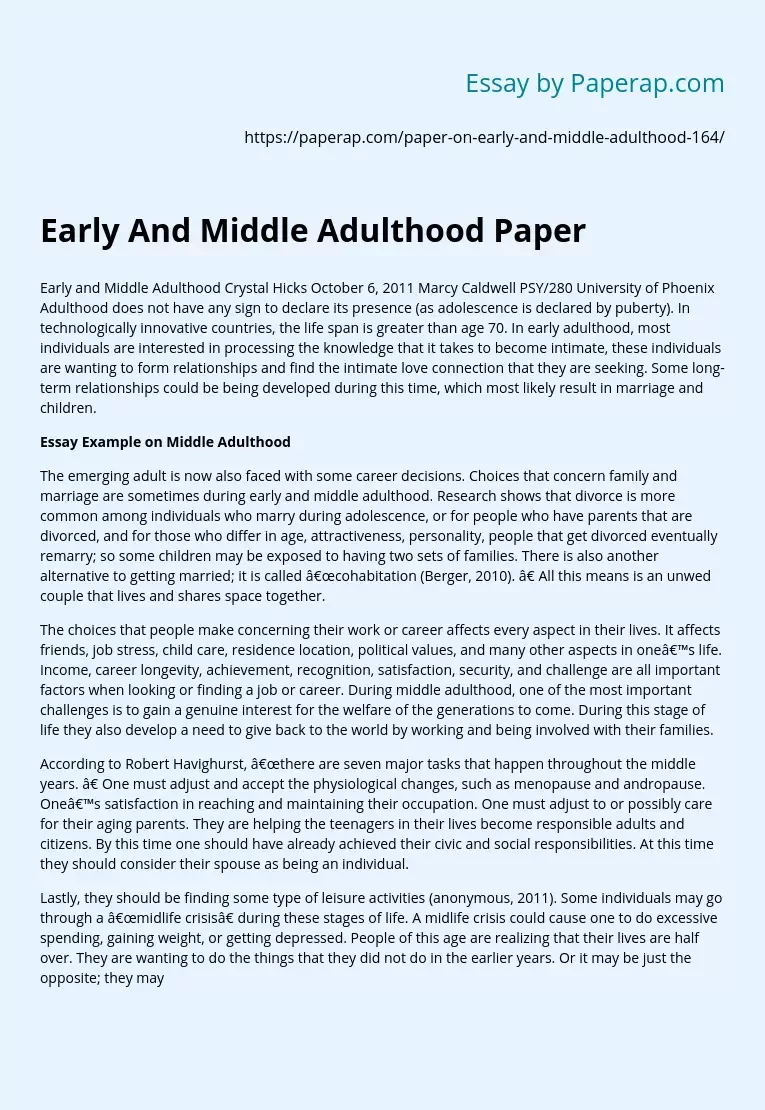Early And Middle Adulthood Paper
Early and Middle Adulthood Crystal Hicks October 6, 2011 Marcy Caldwell PSY/280 University of Phoenix Adulthood does not have any sign to declare its presence (as adolescence is declared by puberty). In technologically innovative countries, the life span is greater than age 70. In early adulthood, most individuals are interested in processing the knowledge that it takes to become intimate, these individuals are wanting to form relationships and find the intimate love connection that they are seeking. Some long-term relationships could be being developed during this time, which most likely result in marriage and children.
Essay Example on Middle Adulthood
The emerging adult is now also faced with some career decisions. Choices that concern family and marriage are sometimes during early and middle adulthood. Research shows that divorce is more common among individuals who marry during adolescence, or for people who have parents that are divorced, and for those who differ in age, attractiveness, personality, people that get divorced eventually remarry; so some children may be exposed to having two sets of families.
There is also another alternative to getting married; it is called “cohabitation (Berger, 2010). ” All this means is an unwed couple that lives and shares space together.
The choices that people make concerning their work or career affects every aspect in their lives. It affects friends, job stress, child care, residence location, political values, and many other aspects in one’s life. Income, career longevity, achievement, recognition, satisfaction, security, and challenge are all important factors when looking or finding a job or career.
During middle adulthood, one of the most important challenges is to gain a genuine interest for the welfare of the generations to come. During this stage of life they also develop a need to give back to the world by working and being involved with their families.
According to Robert Havighurst, “there are seven major tasks that happen throughout the middle years. ” One must adjust and accept the physiological changes, such as menopause and andropause. One’s satisfaction in reaching and maintaining their occupation. One must adjust to or possibly care for their aging parents. They are helping the teenagers in their lives become responsible adults and citizens. By this time one should have already achieved their civic and social responsibilities. At this time they should consider their spouse as being an individual.
Lastly, they should be finding some type of leisure activities (anonymous, 2011). Some individuals may go through a “midlife crisis” during these stages of life. A midlife crisis could cause one to do excessive spending, gaining weight, or getting depressed. People of this age are realizing that their lives are half over. They are wanting to do the things that they did not do in the earlier years. Or it may be just the opposite; they may be wanting to isolate themselves. When one goes through these stages of life, they have found themselves and are focusing on planning for the later years of their lives.
Motivation and determination will play a critical and crucial part in these stages of adulthood. Eventually, they are going to want to retire and just be able to enjoy their lives. Whatever the case may be, we all have to face the fact that we cannot stay young forever. References CliffsNotes. com. Development in Early & Middle Adulthood. 6 Oct 2011 < http://www. cliffsnotes. com/study_guide/topicArticleId-25438,articleId-25385. html>. EBOOK COLLECTION: Berger, K. S. (2010). Invitation to the Life Span. New York: Worth Publishers.
Early And Middle Adulthood Paper. (2019, Nov 27). Retrieved from https://paperap.com/paper-on-early-and-middle-adulthood-164/

